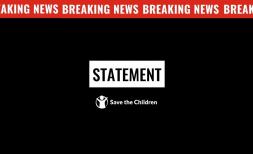Ukraine: Thousands of children lack safe drinking water as Kakhovka Dam crisis unravels
![Stanislav*, 57, with his wife Oksana*, Anastasiia*(3), Mariia*(14), Victoria*(9), Larisa*(9), and Olga*(14) [left to right] pose for a family portrait in the garden near their house in Southern Dnipro, Ukraine](https://i.stci.uk/sites/www.savethechildren.net/files/styles/article_full/public/field/image/CH1845457_Stanislav%2C%2057%2C%20with%20his%20wife%20Oksana%2C%20Anastasiia%283%29%2C%20Mariia%2814%29%2C%20Victoria%289%29%2C%20Larisa%289%29%2C%20and%20Olga%2814%29%20pose%20for%20a%20family%20portrait%20in%20the%20garden%20near%20their%20house%20in%20Southern%20Dnipro%2C%20Ukraine.%20%281%29.jpg)
Stanislav*, 57, with his wife Oksana*, Anastasiia*(3), Mariia*(14), Victoria*(9), Larisa*(9), and Olga*(14) [left to right] pose for a family portrait in the garden near their house in Southern Dnipro, Ukraine. More content available here
KYIV, 25 July 2023 – More than one million people in Ukraine are experiencing severe water shortages following the Kakhovka Dam explosion, depriving children of safe drinking water and dehydrating crops which could further drive up food prices, Save the Children said.
Ukraine’s Ministry of Environment Protection and Natural Resources said about 1.25 million people – including about 310,000 children according to a Save the Children calculation[1] – from the Dnipro, Zaporizhzhia, Mykolaiv, and Kherson regions are without stable water supplies. About 700,000 people require assistance to get safe drinking water.
Kakhovka Reservoir, one of the largest in Europe, was known as the Kakhovka Sea due to its massive expanse of 18 cubic kilometres - about the same volume as Great Salt Lake in Utah, United States. The reservoir was the central water source for many towns, villages, and for farmlands in southern Ukraine.
When the dam was destroyed on 6 June, mass flooding swept through 80 towns and villages along the Dnipro River, forcing about 3,600 people, including 600 children, from their homes as water levels rose above 5 metres in some communities, covering the rooftops of houses.
Southern Dnipro region is the hardest hit. Water levels in the Dnipro river have depleted depleted by 70%, disabling pumping stations and depriving communities along the riverbank of a water source. For these communities, drinking water is provided solely by aid organisations.
“Drinking water is handed out every other day – two litres per person. The distribution usually starts at noon, and there are already 300 people in line by that time. We have no problems with process water, though – to take shower, to wash dishes, and to clean the toilet – but I can only carry three to four buckets at a time because my back hurts,” said Serhii*, 68, who lives in a small town in southern Dnipro.
Stanislav*, 57, and his wife Oksana* live in a village nearby with their five adopted children. An old cistern in their backyard, in which they previously stored water, is now empty. The bottled water distributed by volunteers is not enough for the family of seven to drink and cook with, forcing them to resort to river water, which previously they only used for gardening and cattle.
“We have a well that sources water from the river. Of course, it is not good for drinking, but we have to drink it at times. We also go to neighboring villages and towns to collect water and other aid,” Stanislav* said.
The draining of Kakhovka Reservoir has also drastically impaired irrigation of farmlands in the south. Kherson region accounts for about 12% of all vegetables grown in Ukraine but now 94% of all farmlands there are reported to be dehydrated. In Zaporizhzhia and Dnipro regions, 74% and 30% of crops are no longer being irrigated.
The depletion of water in irrigation channels is likely to have an extensive effect on agriculture and people’s livelihoods in the region, while also driving up food prices across the country.
Sonia Khush, Save the Children’s Country Director in Ukraine, said:
“The humanitarian crisis prompted by the destruction of Kakhovka Dam is multilayered, and its long-term impact is only starting to show. I have visited southern Ukraine and seen firsthand the impact of flooding on children. Families that have endured 17 months of shelling now have their housing severely damaged or destroyed by rising water. Their gardens have been completely washed away, leaving many without livelihoods.
“Thousands of families need help repairing water-damaged properties or finding a new place to live. Hundreds of thousands of people are struggling without clean water, while millions of people already plunged into extreme need are about to be hit by an increase in food prices due to a shortage of crops and vegetables.”
Since the Kakhovka Dam explosion, Save the Children has delivered 225 tons of drinking water to affected communities in Kherson, Mykolaiv, and Dnipro regions. Over 12,000 hygiene kits have also been distributed, and about $1.5 million has been paid in cash assistance to families affected by flood and water shortages.
Save the Children is calling on all sides to adhere to obligations under international humanitarian and human rights law, and ensure that civilians and civilian objects, especially those impacting children such as reservoirs, homes, schools, and hospitals, are protected from attack.
Save the Children has been operating in Ukraine since 2014, delivering humanitarian aid to children and their families affected by hostilities. It is now also supporting refugee families across Europe and helping children to access education and other critical services.
ENDS
*names are changed to protect identity.
NOTES:
[1] – According to UNICEF, children account for a quarter of the population in Ukraine – 1.25 x 0,25=310,000. Nonetheless, in frontline communities affected by shelling and hostilities, by Save the Children estimates, the number of children might be significantly lower than verified data suggests.
For more information please contact:
- Vsevolod Prokofiev Vsevolod.Prokofiev@savethechildren.org (based in Kyiv)
- Anna Rauhanen Anna.Rauhanen@savethechildren.org (based in London)
- Our media out of hours (BST) contact is media@savethechildren.org.uk / +44(0)7831 650409
Please also check our Twitter account @Save_GlobalNews for news alerts, quotes, statements and location Vlogs.




